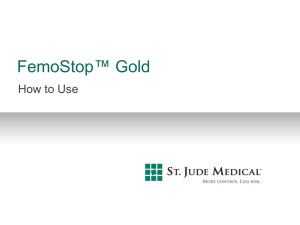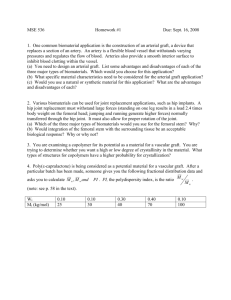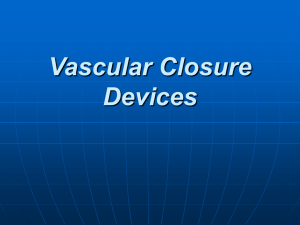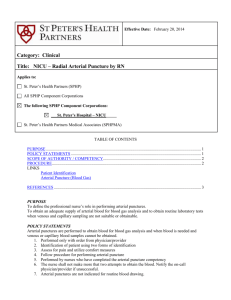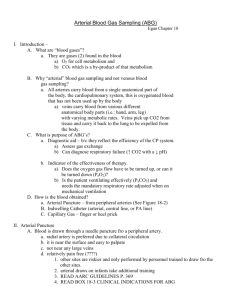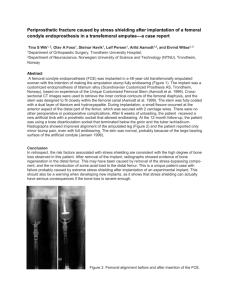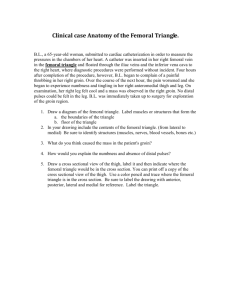Femoral Approach
advertisement
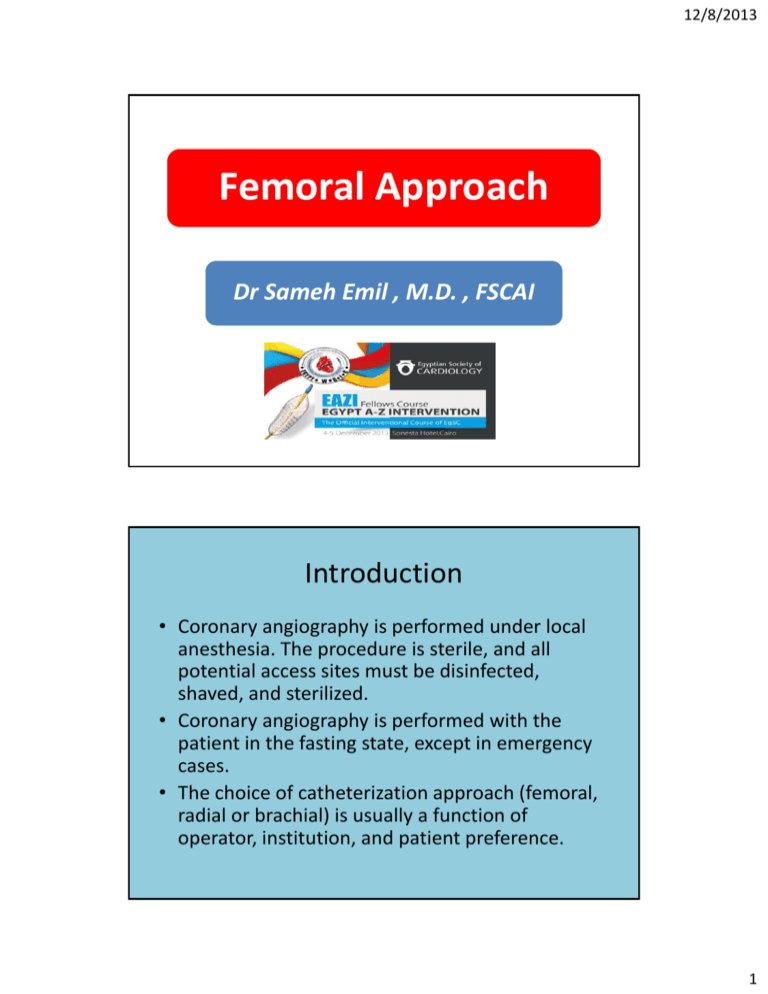
12/8/2013 Femoral Approach Dr Sameh Emil , M.D. , FSCAI Introduction • Coronary angiography is performed under local anesthesia. The procedure is sterile, and all potential access sites must be disinfected, shaved, and sterilized. • Coronary angiography is performed with the patient in the fasting state, except in emergency cases. • The choice of catheterization approach (femoral, radial or brachial) is usually a function of operator, institution, and patient preference. 1 12/8/2013 Arterial puncture • The standard technique of arterial puncture used today is Seldinger technique, developed by SvenIvar Seldinger, a Swedish radiologist, in 1953. • At the site of arterial puncture, an appropriate pulse has to be palpated in order to locate the artery, using the three middle fingers of left hand. • A local anesthesia is applied, usually with 10-15 ml of 1% or 2% lidocaine for local infiltration of the skin and subcutaneous tissues. Arterial puncture • The needle is held in the operator's hand like a pencil, at an angle of 30º-45º against the surface of the skin. • The pointy tip at the distal end of the needle is the first one in contact with the skin, and subsequently with the artery, while the distal needle opening faces upwards. • Arterial puncture is made by advancing the needle to the site of the arterial pulse. • Arterial pressure will produce a pulsatile jet of blood when the needle tip reaches the arterial lumen. • After the arterial puncture, an atraumatic, curvedtipped guide wire (J-wire) is passed through the needle and advanced into the artery without any resistance. 2 12/8/2013 Puncture Site • The most commonly used is right femoral site, as it is the most comfortable access for the operator. • Transfemoral approach is favored because of the larger artery diameter, and therefore the possibility to insert larger arterial sheaths, catheters and bulkier devices. • The proper site is 1-2 cm below inguinal ligament which is attached between anterior superior iliac spine and pubic bone . 3 12/8/2013 Puncture Site The most reliable landmark is probably the junction between the middle and the lower third of the femoral head (radiographic landmark). Advantages of Femoral Access • Clear landmarks : Inguinal crease , bony landmarks , radiological ( head of Femur ) , Doppler guided and Ultrasound guided. • Easier access site . • Shorter learning curve. • Flexibility of sheath size. • Less radiation exposure. • Comfortable operator position. 4 12/8/2013 Limitations of Femoral Access • Delayed ambulation. • Patient discomfort. • Higher vascular complications esp. in anticoagulated and obese patients. • CFA lies just near a major vein (Femoral Vein) and nerve (Femoral Nerve). • CFA is the unique blood supply to the leg. • Time of personnel post cath. Difficulties in Femoral Puncture Weak femoral blood flow: branch , subintimal. • The needle should be removed and the groin should be compressed for 5 minutes. The operator should verify the correctness of the anatomic landmarks and attempt repuncture of the femoral artery. • If the second attempt is unsuccessful in allowing wire advancement, a third attempt on the same vessel is unwise, and an alternative access site should generally be selected. 5 12/8/2013 Difficulties in Femoral Puncture Difficult wire motion : subintimal , iliac disease. • The wire should be pulled back slightly under fluoroscopic control , reassess the blood flow , small bolus of contrast medium is then injected gently under fluoroscopic monitoring. This should disclose the anatomic reason for difficult wire advancement-generally either iliac tortuosity, stenosis, or dissection . 6 12/8/2013 Difficulties in Femoral Puncture Problems advancing the wire above the aortic bifurcation : suggest the presence of an abdominal aortic aneurysm or bifurcation stenosis. Which warrants use of soft-tip hydrophilic guidewires and extreme care to avoid perforation or dislodgment of cavitary thrombus or debris. 7 12/8/2013 Femoral Vein Puncture • The femoral venous puncture is usually performed prior to arterial puncture. With the left hand palpating the femoral artery along its course below the inguinal ligament, the needle is introduced through the more medial position with a 10-mL syringe is attached to the needle , gentle suction is applied to the syringe , as the tip of the needle is in the lumen, venous blood will flow freely into the syringe. Then continue as arterial puncture. Contraindications to Femoral Approach • Peripheral vascular disease (femoral bruits or diminished lower extremity pulses). • Abdominal aortic aneurysm. • Marked iliac tortuosity. • Prior femoral arterial graft surgery. • Gross obesity. • Inability to obtain hemostasis after catheter removal. 8 12/8/2013 Complications Complications 9 12/8/2013 Bleeding - Hematoma • • • • Most common complication post PCI. 90% of bleeding at the access site. Either minor oozing or frank bleeding. Manifests as a hematoma. Bleeding - Hematoma • Symptoms & Signs : - Site pain. - Difficulty in moving leg / hip. - Possible tachycardia or hypotension. - Red / purple skin discoloration. - Swelling at insertion site ( hematoma ). - Loss of pedal pulse in affected leg. 10 12/8/2013 Bleeding - Hematoma • Management : - Prolonged manual compression. - Mark the hematoma boundaries. - Close observation of vital signs. - Measure the thigh girth. - Stop or correct anticoagulation (Protamine). - Blood transfusion ( if needed ). Pseudoaneurysm • Accumulation of blood forming a sac surrounding an intimal disruption of the arterial wall without involvement of other layers. 11 12/8/2013 Pseudoaneurysm • Symptoms & Signs : - Groin pain. - Back pain. - Swelling at groin site. - Ecchymosis. - Pulsatile mass. - Bruit. • Management : - Close observation. - Prolonged compression. - Thrombin injection. - Surgery ( if needed ). Retroperitoneal Hematoma • Results from blood leak into the retroperitoneal compartments as a result of puncturing the posterior wall of the femoral artery above the inguinal ligament or the presence of peripheral arterial disease in external iliac artery. 12 12/8/2013 Retroperitoneal Hematoma • Symptoms & Signs : - Groin pain. - Low abdominal pain. - Hypotension , tachycardia. - Anemia. - Abdominal tenderness. - Brusies around umbilicus & flanks. Retroperitoneal Hematoma • Diagnosis : - High clinical suspicion. - Clinical manifestations. - Ultrasound. - CT or MDCT. - MRI. 13 12/8/2013 Retroperitoneal Hematoma • Management : - Stop anticoagulation. - Fluid replacement. - Blood transfusion. - Conservative close observation. - Endovascular ( graft stent ). - Surgery. Arterio-Venous Fistula • Rare. • Usually occurs when needle puncture artery & vein , more likely with a low femoral puncture as the vein is posterior to the artery. • Manifests as groin swelling & leg pain. • Possible tachycardia & hypotension. • Possible high-output manifestations. • Bruit. 14 12/8/2013 Arterio-Venous Fistula • Management : - Small : spontaneously close. - Indications for repair : * High output failure . * Persistent tenderness . * Leg edema . * Vascular steal . - Repair : Surgery – Covered stent – Coils . Neuropathy • Rare. • After large hemorrhage or pseudoaneurysm: - Pressure exerts on medial & intermediate cutaneous nerves. - Usually resolves when cause resolves. 15 12/8/2013 Arterial Occlusion Endovascular intervention From contra-lateral limb. Sheath Removal • When to Remove : - Diagnostic procedures : immediately. - PCI : 4-6 hours to give Heparin time to dissipate & to be a ready access if abrupt closure occurs. • Ways to achieve Hemostasis : - Manual compression. - Compression Devices ( C- clamp – Femostop ). - Vessel Closure Devices ( VCD ). 16 12/8/2013 Manual Compression Typically 2 hands are used initially, one over the top of the other without the use of gauze. • Downward pressure on the artery with fingertips just superior to the skin puncture site . • Puncture site should always be visible, ensuring blood has stopped oozing. • Maintain direct, non-occlusive arterial pressure for a minimum of 5 minutes. • If oozing should occur, apply additional nonocclusive pressure until hemostasis is achieved. Manual Compression Incorrect Correct method 17 12/8/2013 C - Clamp The C-clamp device consists of a hand adjustable clamp that applies pressure to the artery. A transparent sterile disc is applied over the femoral artery puncture site until hemostasis is obtained. Femostop The FemStop device uses a small pneumatic pressure dome, a belt and a pump. 18 12/8/2013 Mechanical Compression Devices • Advantages : - Hands-free operation. - Decreased contact with blood. - Controlled pressure. • Disadvantages : - Cannot be used on obese. - Severe peripheral vascular disease. - Femoral artery or femoral venous grafts . Vessel Closure Devices ( VCD ) • Vascular closure devices are an alternative to manual and mechanical compression to achieve hemostasis after PCI. • Suture Based: Perclose • Collagen Based: Angio-Seal, VasoSeal • Synthetic Biosealant Based: Mynx • Gel/foam Based: Duett, QuickSeal • Staple Based: StarClose, Angiolink 19 12/8/2013 Vessel Closure Devices ( VCD ) • • • • Advantages : Minimize patient discomfort associated with sheath removal. Reduce the need for long recumbent position following procedure. Decrease the time to ambulation. Shorten time to potential hospital discharge. Vessel Closure Devices ( VCD ) Indications: • Discomfort Associated with Sheath Removal • Inability to tolerate prolonged supine position in selected patients due to a variety of Co-morbid conditions including: - Genital Urinary Problems (e.g. BPH) - Spinal Stenosis - Congestive Heart Failure - Severe COPD - Severe Valvular Disease - Patients with Various Mental Disable Conditions 20 12/8/2013 Vessel Closure Devices ( VCD ) Although most of the currently available access site closures devices have reduced time to ambulation and hemostasis with similar complication rates compared to manual compression, the adoption rate is relatively low due to limitations associated with these devices. Perclose Starclose Angioseal 21 12/8/2013 22 12/8/2013 THANK YOU FOR ATTENTION 23 12/8/2013 Question 2 • An 81 y woman develops groin pain and hypotension 2 hours after manual 6F sheath removal with manual compression. The most important next steps in management include all of the following, except: A. Compression of the groin access site B. Secure large-bore IV access C. Abdominal CT scan D. Reverse anticoagulation Question 3 • You are preparing to obtain femoral access in a morbidly obese patient. Which strategy is most likely to yield the most accurate sheath insertion in the target zone of the common femoral artery? A. Check fluoroscopic position of a clamp at intended puncture site, while palpating femoral pulse B. Insert the needle at the inguinal crease and advance until the artery is entered C. Palpate the anterior iliac crest and the symphysis pubis, then insert the needle along the line midway between the two landmarks D. Assume a shallow angle with the needle, to glide under the pannus 24 12/8/2013 Question 4 • One day after cardiac catheterization from 6F right common femoral access, your patient is asymptomatic, but has a new bruit in the groin. Duplex ultrasound showed arterio-venous fistula. What do you recommend to the patient? A. Continue to observe, unless symptoms develop B. Surgical ligation C. Consider PTFE-covered self-expanding stent D. Coil embolization Question 5 • At the conclusion of a PCI you elect to use a collagen-plug mediated VCD. The patient later asks you why you chose to use a closure device, when during prior catheterizations, she has always had MC . Which statement best justifies your decision ? A. It will reduce the risk of bleeding B. It will shorten the time to hemostasis C. It will reduce the likelihood of developing a groin infection D. It will reduce the chance of requiring vascular surgery 25

